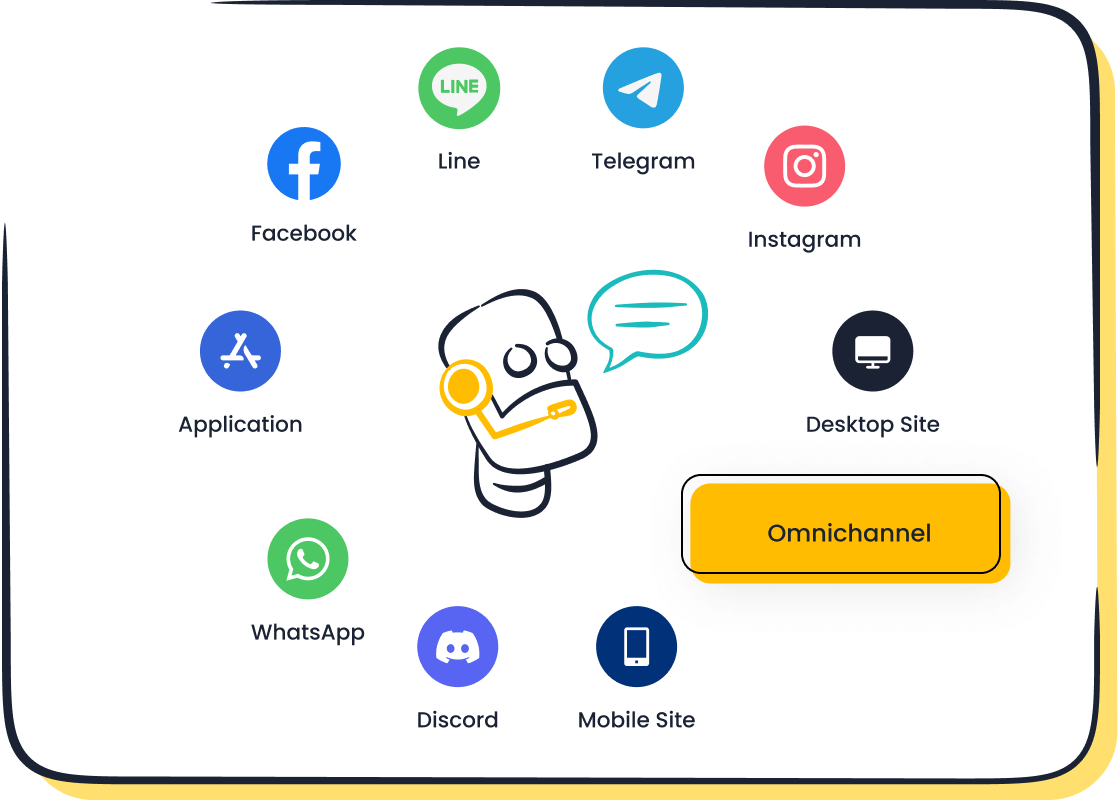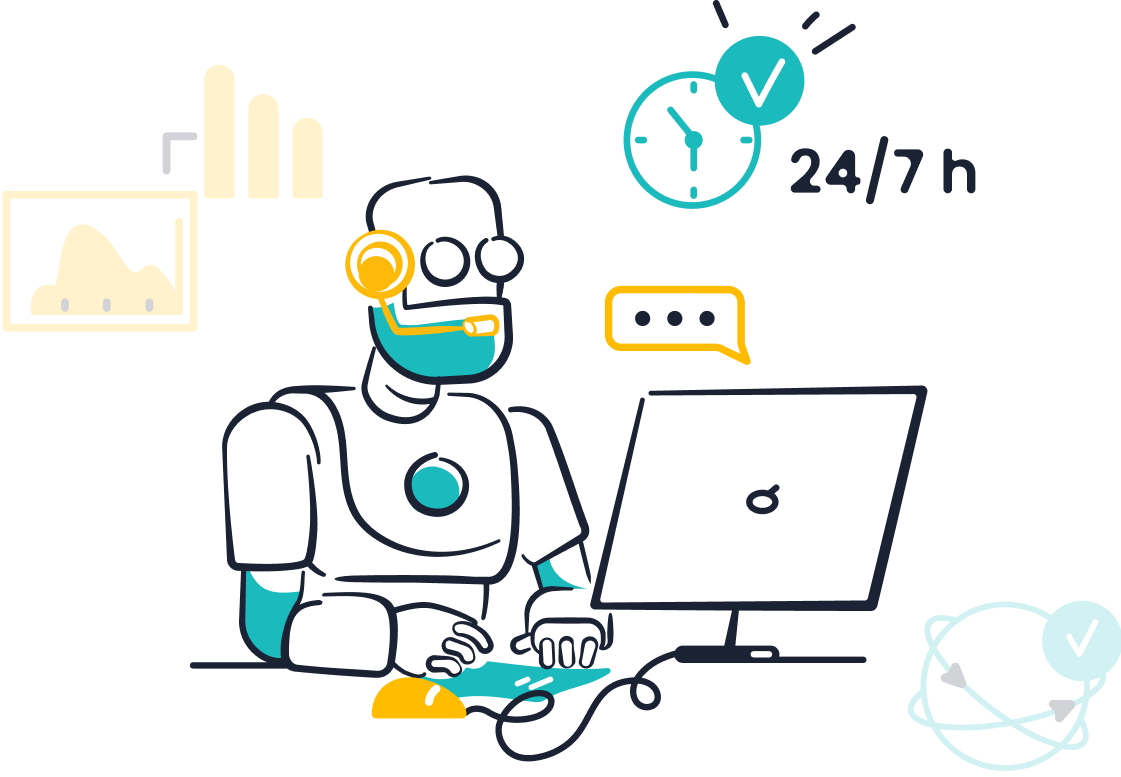Omnichannel vs Multichannel Customer Support Explained

Customer support strategies have evolved to meet rising expectations. Multichannel customer support allows you to interact with customers through various independent platforms like email, phone, or social media. In contrast, omnichannel customer service integrates these channels into a unified system, ensuring seamless communication.
This distinction matters because 77% of customers find it frustrating to repeat themselves across touchpoints. With omnichannel solutions like those offered by Sobot, you can enhance customer experience by providing consistent and personalized interactions. Aligning your strategy with customer needs ensures satisfaction and loyalty.
What Is Multichannel Customer Support?
Definition and Features of Multichannel Support
Multichannel customer support allows you to interact with customers through multiple independent platforms. These platforms include email, phone, social media, and live chat. Each channel operates separately, giving customers the freedom to choose their preferred method of communication. However, these channels do not share data or integrate with one another.
This approach provides a 360-degree view of the customer. It helps you understand their expectations and improve your offerings. Multichannel support also gives you a competitive advantage by identifying gaps in competitors' strategies. You can focus on neglected channels to stand out. Additionally, it enhances sales management by using crowdsourced information to assess performance and efficiency.
| Benefit | Description |
|---|---|
| 360-degree view of the customer | Helps companies understand customer expectations and improve offerings. |
| Competitive advantage | Identifies gaps in competitors' strategies, allowing focus on neglected channels. |
| Better sales management | Utilizes crowdsourced information to assess performance and improve efficiency. |
| Greater visibility and sales | Increases customer reach and reinforces brand messaging across multiple channels. |
| Increased engagement | More channels lead to higher potential customer interaction and communication options. |
Common Applications of Multichannel Support
Multichannel customer support is widely used in industries like retail, financial services, and gaming. Each support channel caters to different customer preferences. For example, some customers prefer email for detailed inquiries, while others may choose social media for quick responses. Tailoring support to various levels of technical expertise enhances customer satisfaction.
You can also use multichannel support to increase engagement. Offering multiple communication options allows customers to interact with your business in ways that suit them best. This flexibility improves the overall customer experience and builds loyalty.
Examples of Multichannel Support in Action
Imagine a retail business using email for order confirmations, phone support for urgent issues, and social media for promotions. Each channel serves a specific purpose, ensuring customers have options. Another example is a gaming company offering live chat for technical support and forums for community discussions. These examples show how multichannel customer support adapts to diverse customer needs.
What Is Omnichannel Customer Support?
Definition and Features of Omnichannel Support
Omnichannel customer service integrates all communication channels into a single, unified system. Unlike multichannel support, where each platform operates independently, omnichannel ensures seamless transitions between channels. This approach allows you to provide consistent and personalized interactions, regardless of how your customers choose to connect with you.
Key features of omnichannel customer support include:
- Unified Customer Data: All customer interactions are stored in one place, enabling agents to access complete histories instantly.
- Seamless Channel Switching: Customers can start a conversation on one channel, like email, and continue it on another, such as live chat, without repeating themselves.
- AI-Driven Insights: Advanced analytics tools provide insights into customer behavior, helping you optimize your support strategies.
- Scalability: Omnichannel systems grow with your business, adapting to increasing customer demands.
Metrics like the Normed Fit Index (NFI) and Comparative Fit Index (CFI) validate the effectiveness of omnichannel systems. These metrics highlight how well these systems enhance customer journeys, improve service metrics, and build trust.
How Omnichannel Enhances Customer Experience
Omnichannel customer service transforms the way you interact with your customers. It ensures they feel valued and heard across all communication channels. This approach builds trust and loyalty, as customers receive consistent support tailored to their needs.
A seamless omnichannel experience allows your team to resolve issues faster. For example, AI-driven analytics can transcribe conversations and uncover customer sentiment, enabling agents to address concerns more effectively. This consistency across channels not only improves efficiency but also strengthens relationships with your customers.
Studies show that customers remain loyal not just for products but for the quality of service. By adopting an omnichannel contact center, you can enhance satisfaction and create lasting connections.
Examples of Omnichannel Support in Action
Real-world examples demonstrate the power of omnichannel customer support:
| Company | Industry | Strategy | Results |
|---|---|---|---|
| FirstBank | Financial Sector | Integrated SMS solutions for account notifications and personalized offers | Enhanced customer experience and engagement through timely alerts and offers. |
| AAA | Roadside Assistance | Text-enabled toll-free number for assistance requests | Nearly 10,000 monthly inbound texts and an 8% conversion rate to service requests. |
| Zenyum | Healthcare Tech | AI bot across multiple channels for personalized support | Handled over 25,000 new sessions and exchanged more than 900,000 messages across four channels. |
| Retailers | Retail & Ecommerce | Conversational AI for personalized shopping experiences | 30-50% increase in conversions and significant reduction in customer care costs. |
These examples highlight how omnichannel systems improve customer satisfaction, reduce costs, and drive conversions. By integrating all channels into a unified system, businesses can deliver exceptional customer experiences.
Omnichannel vs Multichannel: Key Differences

Customer Experience: Seamless vs Independent Interactions
The key differences between omnichannel and multichannel support become evident when examining customer experience. Multichannel systems allow customers to interact through various platforms like email, phone, or social media. However, these channels operate independently, often requiring customers to repeat their issues. This lack of integration can lead to frustration, as 77% of customers dislike repeating themselves across touchpoints.
In contrast, omnichannel support creates a seamless experience by integrating all communication channels. Customers can switch between platforms effortlessly without losing context. For example, a customer might start a conversation on live chat and continue it via email, with the agent already aware of the previous interaction. This approach not only saves time but also enhances satisfaction. Studies show that 92% of customers believe every interaction impacts their overall experience, making seamless communication essential.
Mauro Carobene, a customer interaction expert, highlights the importance of seamless experiences: "A bad interaction is when you repeat the same information... You contact support, go through menus, and then start over with an agent."
Business Impact: Efficiency and Scalability

Omnichannel systems significantly improve efficiency and scalability. By centralizing customer interactions, businesses can resolve issues faster and handle higher volumes. For instance, scalable systems ensure smooth operations during peak demand, such as holiday sales. Automation tools like Sobot's AI Chatbot further enhance efficiency by managing repetitive queries, allowing agents to focus on complex issues.
Multichannel systems, while effective, lack the interconnectedness needed for scalability. Independent channels can lead to operational inefficiencies, especially during high demand. In contrast, omnichannel platforms adapt to growing customer needs, ensuring consistent service quality. Companies with scalable infrastructure, like those using Sobot's omnichannel solution, have demonstrated resilience during challenges like the COVID-19 pandemic.
Data Integration and Insights
Data integration is another area where omnichannel support outshines multichannel systems. Omnichannel platforms consolidate customer data into a unified system, providing a 360-degree view of each interaction. This integration enables agents to deliver personalized support, improving customer satisfaction. For example, centralized data allows agents to access purchase histories, preferences, and past interactions instantly.
Multichannel systems, on the other hand, often store data in silos, making it harder to provide consistent service. Research shows that 65% of customers switch brands after unsatisfactory experiences, highlighting the importance of integrated data. By adopting an omnichannel approach, businesses can gain valuable insights, optimize operations, and build stronger customer relationships.
Benefits of Multichannel and Omnichannel Support

Benefits of Multichannel Customer Support
Multichannel customer support empowers you to connect with customers through various independent platforms. This approach ensures that customers can choose their preferred communication method, whether it’s email, phone, or social media. By offering multiple options, you can cater to diverse preferences and improve accessibility.
One of the key advantages of multichannel contact centers is their ability to enhance efficiency. Agents can specialize in specific channels, allowing them to develop expertise and resolve issues faster. This setup also provides valuable insights into customer behavior on individual platforms, helping you refine your strategies.
Companies adopting multichannel systems have reported significant improvements in customer satisfaction. For example:
- Mapping customer journeys across channels helps identify pain points.
- Collecting feedback from each touchpoint allows you to tailor your services.
- Faster response times on specific channels lead to higher engagement rates.
Benefits of Omnichannel Customer Support
Omnichannel customer support takes personalization and efficiency to the next level. By integrating all communication channels into a unified system, you can provide a seamless customer service experience. Customers no longer need to repeat themselves when switching between platforms, as all interactions are stored in one place.
This approach enhances customer satisfaction by delivering consistent and personalized experiences. AI-powered tools, like Sobot’s omnichannel solution, enable faster issue resolution by providing agents with real-time insights. Customers appreciate the ability to transition smoothly between channels, which improves their overall experience.
| Feature | Multichannel Benefits | Omnichannel Benefits |
|---|---|---|
| Customer Choice | Offers various communication mediums for customers to choose from. | Allows seamless transition between channels, enhancing customer experience. |
| Personalized Experience | Limited personalization as each channel operates independently. | Provides a cohesive experience with context retained across channels, leading to more personalized interactions. |
| Efficiency in Customer Service | Associates focus on one channel, improving their expertise and efficiency. | Faster issue resolution as customers can switch channels without losing context, enhancing overall efficiency. |
| Customer Insights | Insights are limited to individual channels. | Comprehensive understanding of customer journeys across all channels, leading to better service strategies. |
| Cost | Generally lower upfront costs. | Higher initial investment but offers long-term benefits through improved customer satisfaction and retention. |
How Sobot’s Omnichannel Solution Enhances Customer Experience
Sobot’s omnichannel solution revolutionizes customer service by integrating all communication channels into a single platform. This system ensures that every interaction is seamless, personalized, and efficient. With features like AI-driven chatbots and unified customer data, Sobot helps you deliver exceptional service.
The results speak for themselves:
- A 20% reduction in inbound discussion volume.
- A 96% positive feedback rate.
- An 85% problem resolution rate.

Sobot’s solution also improves self-service capabilities, with 22.2% of questions resolved without agent intervention. This not only reduces costs but also enhances customer satisfaction. By adopting Sobot’s omnichannel platform, you can transform your customer service experience and build lasting relationships.
Challenges and Considerations for Implementation
Challenges of Multichannel Support
Implementing multichannel support comes with its own set of hurdles. One of the biggest challenges is technical integration. Combining various systems like CRM and contact center software often requires significant effort. Data management also becomes complex as customer information is scattered across multiple platforms. This fragmentation can lead to inaccuracies, making it harder to deliver consistent service.
Another challenge is training your staff. Agents need specialized skills to handle multiple channels effectively. Without proper training, they may struggle to provide faster resolution to customer issues. Organizational alignment is another obstacle. Shifting from traditional workflows to a customer-centric approach often meets resistance. Balancing initial costs with long-term benefits also requires careful planning.
Challenges of Omnichannel Support
Omnichannel support offers seamless cross-channel integration, but its implementation is far from simple. Managerial confusion often arises due to the complexity of integrating all channels into a unified system. Poor data quality can lead to misguided decisions, as data often resides in disparate systems. Employees may also face challenges in interpreting data correctly, which can hinder customer engagement.
Studies highlight the difficulty of achieving omnichannel success. Ankeny (2016) describes it as "a cipher wrapped inside an enigma smothered in secret sauce." Metrics like the Normed Fit Index (NFI) and Comparative Fit Index (CFI) show the operational challenges businesses face.

Factors to Consider When Choosing a Strategy
When deciding between multichannel and omnichannel support, consider your business goals and customer needs. Evaluate your current systems and identify gaps in customer engagement. If your focus is on flexibility, multichannel support may suffice. However, if you aim for seamless customer experience and faster resolution, omnichannel is the better choice.
You should also assess your resources. Omnichannel systems require higher initial investment but offer long-term benefits. Regularly revisit metrics to ensure your strategy aligns with customer expectations. Effective cross-channel integration and data management are critical for success.
How to Choose the Right Strategy for Your Business
Assessing Business Goals and Customer Needs
Choosing the right strategy begins with understanding your business goals and customer needs. A clear focus ensures your efforts align with your objectives. To achieve this, follow a data-driven approach:
- Define your objectives to clarify what you aim to achieve.
- Identify and collect relevant data systematically.
- Organize the data to uncover patterns and trends.
- Analyze the data to transform it into actionable insights.
- Draw conclusions that align with your business context.
- Implement action plans and evaluate their effectiveness regularly.
Customer experience metrics like NPS, CSAT, and CLV can help you measure how well your strategy meets customer expectations. For example, a telecom provider improved retention and reduced costs by focusing on customer journeys. These insights guide you in tailoring customer support options to meet diverse needs.
Evaluating Technology and Resources
Assessing your technology and resources is crucial for implementing an effective strategy. Tools like Cognota and EHS Insight can help evaluate your training and operational needs. Platforms such as 360 Learning establish feedback loops to improve customer support options.
According to a PwC survey, one in three customers will leave a brand after a single bad experience. This highlights the importance of investing in the right tools to enhance customer journeys. Sobot’s omnichannel solution, for instance, integrates AI-driven automation to streamline operations and improve efficiency. By leveraging advanced technology, you can ensure your strategy adapts to rising customer expectations.
Transitioning to Omnichannel with Sobot’s Chatbot
Transitioning to an omnichannel strategy becomes seamless with Sobot’s AI Chatbot. This tool automates customer interactions, providing a personalized experience across multiple channels. It operates 24/7, ensuring customers receive consistent support throughout their journey.
The chatbot delivers measurable results:
| Metric | Result |
|---|---|
| Reduction in inbound discussion volume | 20% |
| Increase in positive feedback | 96% |
| Correct answers provided by AI | Over 80% |
| Customer satisfaction rate | Over 95% |
For example, Mico App used Sobot’s platform to enhance trust and satisfaction among VIP customers. By adopting Sobot’s chatbot, you can improve customer journeys, reduce costs, and deliver a truly personalized experience.
Choosing between omnichannel and multichannel customer support depends on your goals and customer needs. Omnichannel systems provide seamless transitions, faster resolutions, and comprehensive insights, while multichannel systems offer flexibility but lack integration.
| Benefit/Difference | Omnichannel Support | Multichannel Support |
|---|---|---|
| Customer Interaction | Seamless transition between channels without losing context. | Limited ability to change channels. |
| Resolution Speed | Faster issue resolution as associates can handle issues across channels. | Slower resolution due to channel limitations. |
| Customer Expectations | Meets modern customer expectations for technology and convenience. | Basic options without seamless transitions. |
| Customer Insights | Provides comprehensive insights across all channels for better understanding. | Limited insights due to channel separation. |
| Automation Utilization | Smooth transition from chatbots to live representatives across channels. | Less effective automation due to channel gaps. |
Aligning your strategy with customer expectations ensures satisfaction and loyalty. Evaluate your current system to identify gaps. Sobot’s omnichannel solutions can help you deliver seamless, personalized experiences that meet modern demands.
FAQ
What is the main difference between multichannel and omnichannel customer service?
Multichannel customer service uses separate platforms for communication, while omnichannel integrates all channels into one system. This integration ensures seamless transitions and consistent experiences for customers. Omnichannel systems also provide unified data, making it easier for agents to deliver personalized support.
Why is omnichannel customer service important for businesses?
Omnichannel customer service improves customer satisfaction by offering seamless communication across all channels. It reduces frustration caused by repeating information and ensures faster issue resolution. Businesses benefit from increased loyalty, better insights, and improved operational efficiency, making it a valuable strategy for long-term success.
How does Sobot’s omnichannel solution enhance customer service?
Sobot’s omnichannel solution integrates all communication channels into a unified platform. It uses AI-driven tools to automate repetitive tasks and provide real-time insights. This approach improves efficiency, reduces costs, and ensures customers receive personalized support, enhancing their overall experience with your business.
Can small businesses benefit from omnichannel customer service?
Yes, small businesses can benefit greatly from omnichannel customer service. It helps them compete with larger companies by offering personalized and efficient support. Unified systems streamline operations, reduce costs, and improve customer satisfaction, making it a cost-effective solution for businesses of all sizes.
What role does AI play in omnichannel customer service?
AI enhances omnichannel customer service by automating repetitive tasks, analyzing customer data, and providing real-time insights. Tools like chatbots handle common queries, allowing agents to focus on complex issues. AI also helps businesses understand customer behavior, enabling them to deliver more personalized and efficient support.
See Also
Comprehensive Overview of Omnichannel Call Center Solutions
A Ten-Step Approach to Deploying Omnichannel Contact Centers
Excelling in Live Chat for Enhanced Customer Assistance
Transforming Customer Support with AI Service Agents
Enhancing SaaS Customer Support Through Live Chat Techniques
